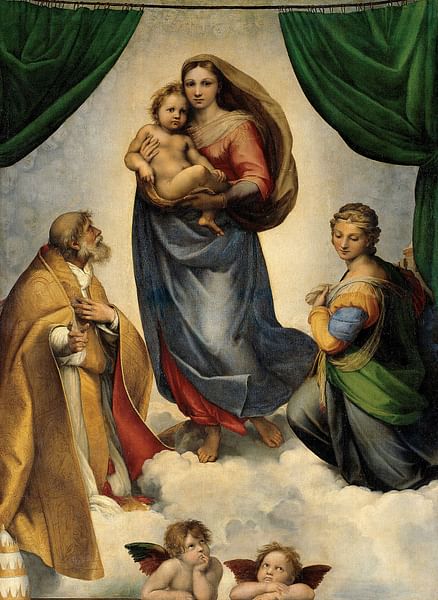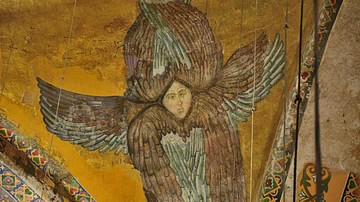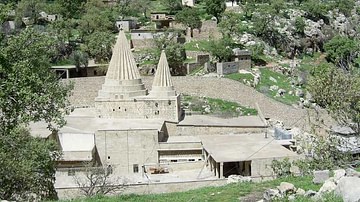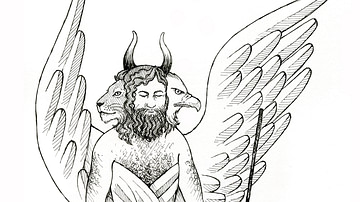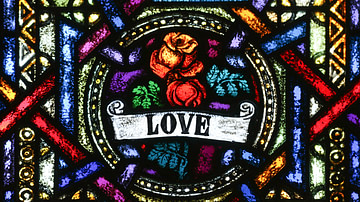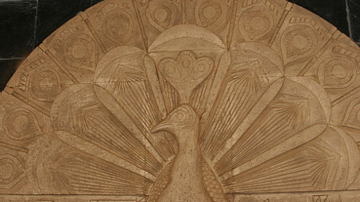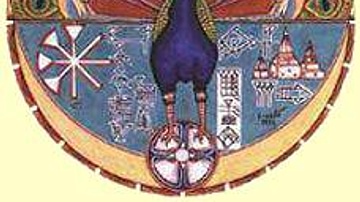Angels in Christianity act as messengers of God, bring good news, and help believers. Their role developed from the function of angels in ancient Judaism but continued to evolve as Christianity became a separate religion.
Jewish & Zoroastrian Origins
What became the independent religion of Christianity emerged in the 1st century CE from the teachings of a Jewish apocalyptic movement based upon the ministry of an itinerant Jewish preacher, Jesus of Nazareth. The prophets of Israel had predicted that God would raise up a messiah ("anointed one") from the line of King David, who would help to usher in God's final intervention in history, the eschaton, the final days. This was to be God's kingdom on earth, to restore the nation of Israel from its oppressors. The result would be a new Eden, God's original plan for humans. Jesus' appearance is described in Mark's gospel: "The time is fulfilled, and the kingdom of God has come near; repent and believe in the good news" (Mark 1:15).
However, various groups of Jews had different views on the nature of the messiah. The Hebrew, "anointed one" in the earliest texts was from the story of the prophet Samuel choosing David as king by literally pouring oil on his head. Others had a more esoteric concept of a divine being.
The Achaemenid Empire ruled the Middle East, which included Israel, until Alexander the Great (r. 336-323 BCE) conquered the region. The state cult of Zoroastrianism influenced concepts in Judaism. The original Persian creator god, Ahura Mazda, a being of pure good, emanated the spenta mainyu (creative spirit/mentality) in pairs of males and females who procreated. These beings created both the physical universe and humans. At the opposite end of the polarity of Ahura Mazda was druj, chaos, disorder, personified as Ahriman.
The spenta mainyu were often referred to with the term yazata to distinguish them from the agents of Ahriman. Yazata was Persian for a being "worthy of worship through song and sacrifices." This gave rise to the oppositional polarity of good against evil (angels and demons), with constant battles between the two forces. In ancient Judaism, only the God of Israel could receive sacrifices, but angels could be petitioned through hymns and prayers for benefits. The idea that humans had a "guardian angel" arose from Zoroastrianism.
Eschatology (the study of events in the final days, from the Greek eschaton) was the idea in Zoroastrianism that ultimately the good creator god Ahura Mazda would rescue all the good people in a final conflagration that would end the world as we know it. He would send the saoshyant, "one who brings benefits" to restore all the good souls. The living and the dead would be reunited and live in peace and harmony. Like the angels, the saoshyant was worthy of worship. This saoshyant figure was understood by some as a pre-existent, divine messiah.
To affirm that Jesus literally came from the line of David, Christians turned to Psalm 2, in ancient context a psalm about David as the first king:
I will tell of the decree of the Lord: He said to me, "You are my son; today I have begotten you. Ask of me, and I will make the nations your heritage and the ends of the earth your possession." You shall break them with a rod of iron and dash them in pieces like a potter's vessel. (Psalm 2:7-9)
However, the term "sons of God" appears for the first time in Genesis, and it refers to the angels. From the beginning, the movement around Jesus was faced with the problem that angels were immortal, but Jesus died by crucifixion. A dead messiah was not much help to the Jews. A resolution was found in an early claim that Jesus was resurrected from the dead and then exalted to heaven to share God's throne.
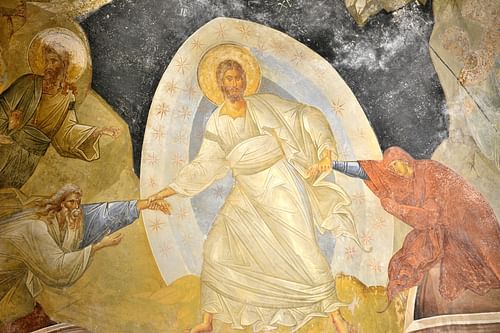
Paul's Letters
Our earliest teachings on Christianity are from the letters of a Pharisee, Paul the Apostle (50s-60s CE). He initially opposed the teachings of this movement. Paul had a divine revelation with a voice that commissioned him to be the apostle to the Gentiles, a messenger, herald to bring the 'good news' (the later concept of 'gospel'). Paul the Apostle traveled to cities in the Eastern Mediterranean and established communities of believing Jews and Gentiles (ex-pagans). In the sense of angels as heralds of messages, Paul could use the analogy for himself:
You know that it was because of a physical infirmity that I first announced the gospel to you; though my condition put you to the test, you did not scorn or despise me but welcomed me as an angel of God, as Christ Jesus.
(Galatians 4:13-14).
Paul openly admitted that the trial and crucifixion of Jesus of Nazareth was a problem: "but we proclaim Christ crucified, a stumbling block to Jews and foolishness to Gentiles" (1 Corinthians 1:23). Subsequently, Paul's teaching about Christ is what scholars describe as Christology, a modern term, for the study of the nature of Christ, divine or human. Paul's letter to the Romans begins:
Paul, a servant of Christ Jesus, called to be an apostle, set apart for the gospel of God, which he promised beforehand through his prophets in the holy scriptures, the gospel concerning his son, who was descended from David according to the flesh and was declared to be son of God with power according to the spirit of holiness by resurrection from the dead, Jesus Christ our Lord
(Romans 1:1-4).
This reflected the early disciples' view of a human being who then ascended to heaven after his resurrection and became immortal.
Paul enhanced his definition of Christ in what would become a central tenet of the new religion after the separation of Christianity from Judaism. Paul's letter to the Philippians contains an early hymn to Christ:
... who, though he existed in the form [nature] of God, did not regard equality with God as something to be grasped, but emptied himself, taking the form [nature] of a slave, assuming human likeness. And being found in appearance as a human, he humbled himself and became obedient to the point of death—even death on a cross. Therefore God exalted him even more highly and gave him the name that is above every other name, so that at the name given to Jesus every knee should bend, in heaven and on earth and under the earth, and every tongue should confess that Jesus Christ is Lord, to the glory of God the Father.
(Philippians 2:6-11)
"The name that is above every other name," refers to the sacred name of God, the letters of YHWH. "That every knee should bend . . . " is the age-old practice of respect, bowing and kneeling before a statue of one of the gods. The consensus interprets this hymn as Paul establishing Christ in the form of God on earth; the basis for the combined worship of God and Christ and the later concept of the trinity, established by the First Council of Nicaea in 325 CE. The line "He existed in the form of God" established Christ as a pre-existent divine being, the first of God's creation, and placed him above and superior to the angels.
Paul eliminated traditional sacrifices in the worship of the native cults for his believing Gentiles. However, the earliest references to the worship of Christ in Paul's letters to the Gentiles mirror the concept of angels. Only God could receive sacrifices, but one could sing hymns and praises to Christ, petition him for benefactions, heal and raise people from the dead in his name.
Throughout Paul's letters, he criticized the 'sexual immorality' of the dominant culture, and in the interim of waiting for Christ to return, in human relationships, the Corinthians were to live like angels, but without details. In 1 Corinthians, the believers still alive at Christ's return would join when the entire universe will be transformed.
Angels in the Gospels
The writers of the gospels and the Acts of the Apostles (70-95 CE) included many stories of the same activities of angels following the traditions of the Jewish Scriptures. Angels appear both physically or in dreams and visions.
In Matthew's story of the birth of Jesus, Joseph encounters unnamed angels several times:
- when he learns that his betrothed, Mary, is pregnant
- when he is warned to take the family to Egypt because of Herod's edict to slaughter newborn males
- in Egypt, when he learns that Herod is dead and they can return home. The Magi were warned in a dream not to report back to Herod", and consistency assumes an angel warned them in that dream.
Matthew 22 introduced a concept that eventually became part of Christian angelology. In what was presented as an oppositional trick question by the Sadducees, seven brothers all married the same widow of the first brother, who then died.
"...In the resurrection [of the dead], then, whose wife of the seven will she be? For all of them had married her." Jesus answered them "You are wrong because you know neither the scriptures nor the power of God. For in the resurrection people neither marry nor are given in marriage but are like angels of God in heaven."
(Matthew 22:28)
In other words, angels were non-sexual beings, never subject to sexual or bodily temptations. As such, they were models against sexual immorality and deviant lifestyles.
Luke's gospel opens with the earlier story of the birth of John the Baptist to the barren couple of Elizabeth and Zacharias. In his rotation as high priest, Zacharias was in the Holy of Holies when an angel appeared and foretold the birth of their son, John the Baptist. Luke added that an angel then appeared to Mary herself to inform her that she would have a son through the "spirit of God" (highlighted as the Annunciation to Mary). After the birth of Jesus, the shepherds in the field were visited by a host of angels, who announced the birth in a paean of glory.
In Luke's parable of The Rich Man and Lazarus, an angel carried the dead Lazarus "to be with Abraham" (Luke 16:22). This story became the basis of later Christian teaching that, when good Christians die, angels accompany and guide them to heaven. In the writings of Bishop Tertullian (155-220 CE):
When by force of death the soul is snatched from the weight of the flesh that closed it in, it trembles with excitement to see the face of an angel, the summoner of souls, realizing that its eternal abode has been prepared."
(De Anima, ch. 53)
The fourth gospel of John replicated Paul's version of a pre-existent Christ. He utilized Plato's concept of the logos (divine rationality), which appeared in physical form for the Christian concept of the incarnation. John consistently referred to "descent" and "ascent." He did not use the word 'crucifixion' but referred to it as Jesus being "lifted up." The pre-existent Jesus descended to earth and then returned back to heaven.
All four gospels have unnamed angels who inhabit the now-empty tomb of Jesus after his resurrection. The angels function as witnesses that Jesus has been resurrected from the dead. They announce this news, first to the women, and then the disciples, and that they are to tell the world.
The Acts of the Apostles
Luke's sequel to his gospel, Acts, is the story of how early Christianity spread from Jerusalem to the cities of the Eastern Mediterranean after Jesus's death through the first Christian missionaries and the journeys of Paul the Apostle. Angels appear everywhere. In Acts 1:9-11, after the ascension of Jesus, two angels appear as witnesses that Jesus has been exalted to heaven. Angels appear to Peter and Cornelius, to Philip, and to Paul. In addition to revelations and explanations, one of the functions of angels in Acts is to motivate the followers to missionize in new cities and provinces. Angels always warn of opposition and persecution but also promise the apostles will receive help from angels through these ordeals.
In the book of Revelation (apocalypse) of John of Patmos, in his visions of the final days, a series of angels guide John through tours of heaven and open scrolls to reveal what would happen when Christ instituted his kingdom on earth. In Revelation, it is Michael the archangel who earlier threw the rebellious angel Satan out of heaven, and who is finally destroyed by Christ.
In the New Testament Letter to the Hebrews, we have more arguments for angels as subservient to Christ:
For to which of the angels did God ever say, "You are my Son; today I have begotten you?" ... And again, when he brings the firstborn into the world, he says, "Let all God's angels worship him."
(Hebrews 1:5-7)
Guardian Angels
The concept of guardian angels was enhanced in Matthew 18:
At that time the disciples came to Jesus and asked, "Who is greatest in the kingdom of Heaven," he called a child, whom he put among them, and said, "Truly I tell you, unless you change and become like children, you will never enter the kingdom of heaven. ... Take care that you do not despise one of these little ones, for I tell you, in heaven their angels continually see the face of my father in heaven."
(Matthew 18:1-3; 18:10)
In the 4th-century CE establishment of the cult of the saints, Christians elevated those who died as martyrs as being transformed into the presence of God. Martyrs share the privilege of angels in being closest to the throne of God and also now act of mediators who can be petitioned for individual and community benefits.
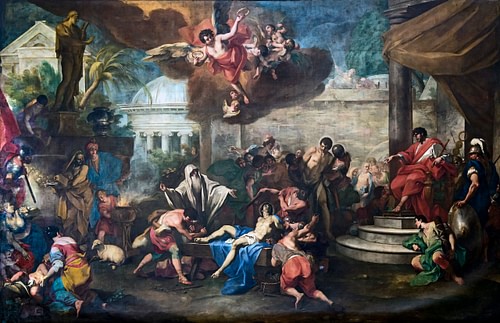
Angels in Late Antiquity & the Middle Ages
With Constantine’s conversion to Christianity, the Roman emperor conferred legality on the Christian movement in the Edict of Milan in 313 CE. He simultaneously promoted Christian iconography through elaborate mosaics and portraits. As God's representative on earth, Constantine I and subsequent emperors were portrayed with halos. This became the standard iconography for angels. The archangels held swords, in their role of carrying out God's commandments. Angel images were incorporated into church murals and cathedral architecture.
Angels continued in their basic function to periodically bring the "good news" of God or Christ and to help individual believers. In the literary device of romance literature, the stories of earlier martyrs were enhanced with details of angels performing miracles to reduce the pain and suffering of the persecuted. A group of women were honored as virgin martyrs. While in prison, they had to suffer attempted rape by the legionaries, but angels always help them to resist. The 4th-century CE martyred saint, Catherine of Alexandria, was attended by angels throughout her ordeals, bringing her food and water. After dying for their faith, many of these martyrs were taken to heaven by angels.
The dominant institution of the Middle Ages was the Catholic Church which served as the kingdom of God until Christ returned. In context, stories of angels validated the rituals and rules of the medieval Church, with angels utilized in both reward and punishment for divergent views and sins. One could also appeal to angels to implement justice in this world against a disaster or an opponent, while awaiting God's kingdom.
Monastics were also considered "living martyrs" and elevated to heaven after their death. What became the institution of monasticism was founded by Anthony of Egypt (251-356 CE). Anthony retreated to the desert to concentrate solely on God. Removed from normal life, the daily life of medieval monks included asceticism through chastity, celibacy, and limited intake of daily food. In contemporary literature, they were described as "living angels," battling the Devil and demons against temptation. The Devil would appear in dreams, and the harsh living conditions of a medieval monastery were construed as taking on the terrors of hell in the afterlife.
Renaissance Literature & Art
In Dante Alighieri's Divine Comedy, angels guide him through the Inferno (Hell), Purgatory, and Paradise. These angels are free of physical matter, pure intelligence, whose purpose is to act out the will of God. During the Renaissance (14th to 16th centuries), angel iconography became a popular way in which to illustrate traditional Bible stories. Artists depicted angels in contemporary dress, but with wings and halos.
Artists such as Giotto (1267-1337), Hieronymus Bosch (1450-1516), and Michelangelo (1475-1564), depicted polarized views of angels and demons and the fate of humans.
It was in this period that archeological remnants of ancient Rome were discovered. Wall decorations revealed the putti ("young boys"), depictions of Eros, the son of Venus. These became the cherubs of Christian Art. It was a preferred way to remove the aggressiveness and sometimes punishment of the original cherubim to an image of innocence and goodness.




